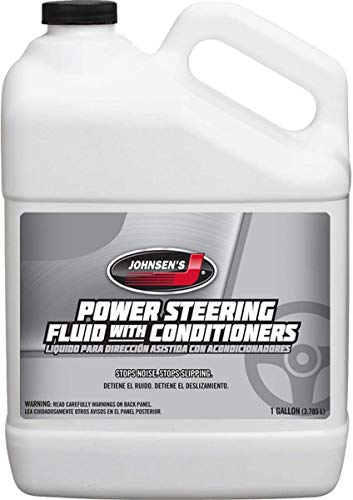Have you ever noticed a puddle of fluid under your car and wondered what it could be? If you’ve seen a power steering fluid overflow, it’s essential to pay attention.
Ignoring it can lead to bigger problems down the road. Understanding why you should track this overflow is crucial for your vehicle’s health and your safety on the road. You’ll discover the reasons behind power steering fluid overflow and how it can impact your driving experience.
You’ll learn simple ways to monitor your fluid levels and what signs to look for. This knowledge could save you time, money, and headaches in the future. Keep reading to ensure your car runs smoothly and remains reliable for every journey.
Importance Of Power Steering Fluid
Understanding the importance of power steering fluid is essential for maintaining your vehicle’s performance. This fluid not only facilitates smooth steering but also plays a crucial role in prolonging the lifespan of your steering system. Regularly tracking and managing power steering fluid levels can lead to a more responsive and enjoyable driving experience.
Role In Smooth Steering
Power steering fluid is the lifeblood of your steering system. It helps you maneuver your vehicle effortlessly, making turns and adjustments feel seamless. Without adequate fluid, you might notice your steering becoming stiff and unresponsive, making driving a chore rather than a pleasure.
Consider a recent drive I took through winding roads. The fluid was just right, and I felt in complete control as I navigated sharp turns. However, it wasn’t always this way; there was a time when I neglected checking the fluid, and I experienced a significant difference in steering responsiveness.
Preventing Wear And Tear
Maintaining the right level of power steering fluid is essential for preventing wear and tear on your steering components. Low fluid levels can lead to increased friction, causing parts to degrade faster. This can result in costly repairs down the line.
Think about it: when you keep your power steering system well-lubricated, you’re essentially investing in your vehicle’s longevity. Regular checks and top-ups can save you from unexpected breakdowns and expensive repairs. Have you checked your fluid levels lately?
Incorporating this simple practice into your routine can make all the difference. It takes just a few minutes to check and ensure everything is in order. Your future self will thank you for it.
Causes Of Fluid Overflow
Understanding why power steering fluid overflows is important. Several factors can cause this issue. Let’s explore the most common causes.
Overfilling The Reservoir
One major cause is overfilling the fluid reservoir. This happens when too much fluid is added. It can lead to excess pressure inside the system. This pressure forces fluid out of the reservoir.
Always check the recommended fluid level. Use the dipstick or markings on the reservoir. Adding fluid should be done carefully. Avoid filling past the maximum line.
Temperature Changes And Expansion
Temperature changes can also cause fluid overflow. Fluids expand when heated. Hot weather or engine heat raises fluid temperature.
As the fluid expands, it needs more space. If the reservoir is full, excess fluid spills out. Be mindful of temperature effects on your vehicle.
Leaks And Contaminants
Leaks are another reason for fluid overflow. A damaged hose or seal can cause fluid to escape. This leads to low fluid levels, prompting a refill.
Contaminants can also affect the fluid. Dirt and debris in the system can cause blockages. This buildup can lead to pressure changes, resulting in overflow.
Signs Of Fluid Overflow
Tracking car power steering fluid overflow is important. Signs of overflow can indicate problems. Low fluid levels may affect steering and cause damage. Regular checks can help avoid bigger issues.
Identifying signs of power steering fluid overflow is crucial for maintaining your vehicle’s performance and safety. If you notice any irregularities, it’s essential to address them quickly. Here are some common indicators that your power steering fluid may be overflowing.Puddles Under The Car
Have you ever parked your car and noticed a strange puddle beneath it? If the liquid is reddish-brown, it could be power steering fluid. This sign indicates that your system is overfilled or has a leak. Ignoring these puddles can lead to more significant issues down the line. Make it a habit to check under your vehicle regularly. A small puddle can quickly become a bigger problem.Unusual Steering Resistance
Do you find it harder to turn your steering wheel lately? Increased resistance can be a clear sign of power steering fluid issues. When the fluid overflows, it can create a buildup of pressure in the steering system. This pressure affects how smoothly your steering operates. You might also experience a “sticky” feeling, making it harder to maneuver your vehicle. If your steering feels off, it’s time to investigate further. Consider how this could impact your driving experience—would you feel safe on the road?Burning Odor Or Smoke
Have you ever caught a whiff of something burning while driving? A burning odor can signal power steering fluid overheating. When fluid overflows, it can come into contact with hot engine parts, leading to smoke and unpleasant smells. This situation not only affects your car’s performance but can also pose safety risks. If you detect any strange smells, pull over and inspect your vehicle immediately. What if this warning sign leads to a more serious engine issue? Stay alert and address any odd sensations or scents that arise. Being proactive can save you time and money in repairs later.Risks Of Ignoring Overflow
Ignoring power steering fluid overflow can lead to serious issues. Low fluid levels can cause steering problems, making it hard to control your car. Tracking overflow helps ensure safe driving and protects your vehicle from damage. Regular checks can save you from costly repairs down the road.
Ignoring power steering fluid overflow can lead to serious issues. Many drivers overlook this problem, thinking it’s just a minor inconvenience. However, this oversight can snowball into larger, more costly complications.Damage To Steering Components
When power steering fluid overflows, it can create a mess that damages surrounding components. The excess fluid can corrode electronic parts or damage seals. This damage often results in the need for costly replacements. If your steering system isn’t functioning properly, you might notice unusual noises or difficulty turning the wheel. These symptoms signal that your steering components may already be suffering. Regular monitoring can prevent these problems from escalating.Increased Repair Costs
Ignoring fluid overflow can lead to extensive repairs. Over time, the damage can accumulate, resulting in a hefty bill. Instead of a simple fluid top-off, you may end up replacing entire steering assemblies. Have you ever faced a situation where a small issue turned into a major expense? That’s exactly what can happen if you disregard fluid overflow. Keeping an eye on your power steering fluid can save you money in the long run.Potential Safety Hazards
Let’s talk about safety. An overflowing power steering fluid reservoir can impair your ability to steer effectively. This can lead to dangerous situations, especially at high speeds or in emergency maneuvers. Imagine driving on a busy highway when your steering suddenly becomes unresponsive. It’s a frightening thought, isn’t it? Staying vigilant about your vehicle’s maintenance, including monitoring power steering fluid, can protect you and your passengers. Taking the time to track and manage power steering fluid overflow is an easy step you can take for your car’s health and your safety. Don’t wait for a small issue to turn into a big problem. Stay proactive, and keep your driving experience smooth and safe.How To Monitor Fluid Levels
Tracking car power steering fluid overflow is crucial for vehicle health. Low fluid levels can cause steering issues. Regular monitoring helps prevent damage and ensures smooth driving. Keeping an eye on this fluid can save you from costly repairs.
Monitoring your track car’s power steering fluid levels is crucial for maintaining optimal performance. Proper fluid levels ensure your steering system operates smoothly and efficiently. It can be the difference between a tight corner and a disastrous spin. Here’s how you can easily monitor those fluid levels.Checking The Reservoir
Start by locating the power steering fluid reservoir. It’s typically found near the engine, marked with a recognizable cap. Open the cap and check the fluid level against the markings on the side of the reservoir. If the level is below the minimum line, it’s time to add more fluid. Always wipe the dipstick with a clean rag before checking to avoid contamination. Regular checks can prevent potential steering issues. Remember, a little attention goes a long way.Using The Correct Fluid Type
Using the right type of power steering fluid is essential. Consult your owner’s manual for specifications. Many cars require specific fluid types, and using the wrong one can lead to serious problems. If you’re unsure, ask a professional or visit your local auto parts store. They can guide you to the right product. Mixing different fluid types can cause foaming, leading to reduced performance. Be cautious—always stick to what’s recommended for your vehicle.Inspecting For Leaks
Regularly inspect for leaks around the steering components. Look for any signs of fluid pooling under your car or damp spots around the hoses and connections. A small leak can quickly escalate into a bigger problem, potentially leaving you without steering assistance. If you notice any leaks, address them immediately. It’s better to fix a small issue than to face a costly repair later. Consider using a flashlight for a closer look in tight spaces. Taking these simple steps can save you from unexpected track day mishaps.Preventing Overflow Issues
Tracking car power steering fluid overflow is essential for vehicle health. Overflow can cause damage and lead to expensive repairs. Regular checks help maintain the right fluid levels, ensuring smooth steering and safe driving.
Preventing overflow issues with your car’s power steering fluid is crucial for maintaining optimal performance and safety. A small oversight can lead to significant problems, including damaged components and costly repairs. Understanding how to manage your power steering fluid effectively can save you time and money in the long run.Avoid Overfilling
Overfilling your power steering fluid reservoir can lead to overflow and create unnecessary pressure in the system. Always check the manufacturer’s specifications for the correct fluid level. Use a dipstick or the markings on the reservoir to ensure you’re within the recommended range. If you find yourself consistently overfilling, consider whether you’re using the right type of fluid. Sometimes, switching to a different brand can help maintain the right balance.Regular Maintenance Practices
Regular maintenance is key to avoiding overflow issues. Schedule routine checks of your power steering fluid level, ideally every few months or before long trips. During these checks, look for signs of leaks or contamination, which can indicate deeper problems. Changing the fluid at intervals specified in your owner’s manual keeps the system clean and reduces the risk of overflow. Have you ever wondered how often others neglect this simple task? A little diligence can go a long way in preventing headaches down the road.Keeping The System Clean
A clean power steering system is less likely to experience overflow issues. Dirt and debris can clog lines and create pressure, leading to fluid overflow. Use a funnel when adding fluid to prevent spills and keep contaminants out of the reservoir. Occasionally, flushing the system removes built-up grime and helps maintain optimal function. Have you checked your system lately? You might be surprised at the difference a little cleanliness can make. Taking these proactive steps can help you prevent overflow issues and ensure your power steering system operates smoothly.When To Seek Professional Help
Tracking car power steering fluid overflow is important for safe driving. If the fluid level is too high, it can cause damage to the steering system. Seeking professional help is wise when you notice leaks or unusual steering behavior. Regular checks can prevent bigger problems later.
When it comes to car maintenance, understanding the nuances of your vehicle’s systems can save you time, money, and stress. Power steering fluid overflow is one such issue that might seem minor at first. However, neglecting it can lead to bigger problems down the road. Recognizing when to seek professional help is crucial for keeping your car in top shape.Recurring Overflow Problems
If you find yourself constantly topping off your power steering fluid, it’s time to take action. A recurring overflow indicates a deeper issue within the system. Ignoring this can lead to more severe damage and costly repairs. Consider how frustrating it can be to keep refilling that fluid. Each time you do, ask yourself: What is causing this constant overflow?Unidentified Steering Issues
Have you noticed your steering becoming less responsive or making strange noises? These could be signs that your power steering system is struggling. Fluid overflow often accompanies issues like air bubbles or leaks. You might feel a slight vibration or hear a whine when turning the wheel. Don’t shrug these off. Seek professional help to diagnose the problem accurately.Signs Of System Damage
Physical signs can be a clear indicator that something is wrong. Look for any leaks underneath your car or a noticeable drop in fluid levels. If you see fluid pooling around the steering rack, this is a red flag. Additionally, check for any unusual smells or burning sensations while driving. These could signal damage that needs immediate attention. Ignoring these signs can lead to a complete system failure, so don’t hesitate to consult a professional. Taking action at the right time can help you avoid extensive repairs and keep your vehicle running smoothly. How often do you monitor your power steering fluid levels? Don’t wait until it’s too late.Frequently Asked Questions
What Would Cause Power Steering Fluid To Overflow?
Power steering fluid can overflow due to overfilling, a damaged reservoir, or a failing pump. Leaks in the system can also cause excess fluid. High temperatures may expand the fluid, leading to overflow. Regular maintenance helps prevent these issues and ensures proper fluid levels.
What Is The Most Common Cause Of A Power Steering Fluid Leak?
The most common cause of a power steering fluid leak is a damaged or worn-out hose. Other potential causes include a faulty pump or a leaking reservoir. Regular inspection and maintenance can help prevent these issues and ensure your steering system functions properly.
Why Do I Have To Keep Refilling My Power Steering Fluid?
Frequent power steering fluid refills indicate a leak in the system. A damaged hose, worn seals, or a faulty pump can cause fluid loss. Regularly checking and addressing these issues ensures safe steering performance and prevents further damage to your vehicle.
Always consult a mechanic if fluid levels drop unexpectedly.
How Bad Is It To Overfill Power Steering Fluid?
Overfilling power steering fluid can cause excess pressure in the system. This may lead to leaks, damaged seals, or even system failure. It’s crucial to maintain the correct fluid level for optimal performance. Regular checks can help prevent these issues.
Conclusion
Tracking car power steering fluid overflow is essential for vehicle health. Regular checks can prevent serious issues. Low fluid levels may lead to steering problems. This can make driving unsafe. Keeping an eye on fluid levels saves money on repairs.
It also ensures smoother handling. Take action if you notice leaks or low levels. Protect your car and enjoy a safer ride. Stay proactive for the best driving experience. Your vehicle deserves it.

Benjamin Grey is an automotive engineer and writer at Car Parts Advisor. With years of experience in the automotive industry, he shares expert advice on car parts, maintenance, and repairs to help car owners keep their vehicles running smoothly.



